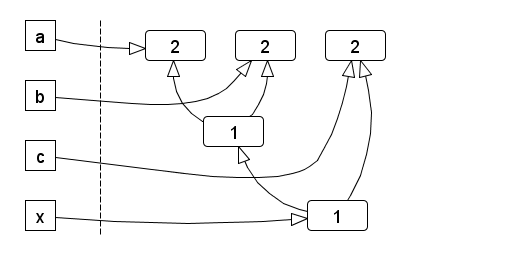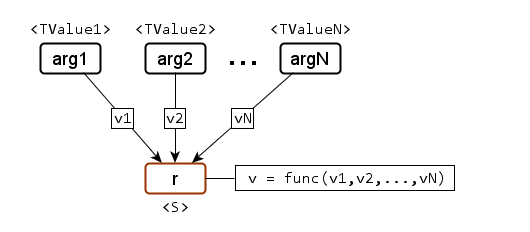-
Notifications
You must be signed in to change notification settings - Fork 130
Signal.h
#include "react/Signal.h"
Contains the signal template classes and functions.
A signal is a reactive variable that can propagate its changes to dependents and react to changes of its dependencies.
Dataflow between signals is modeled as a directed acyclic graph, where each signal is a node and edges denote a dependency relation.
If an edge exists from v1 to v2 that means v1 will propagate its changes to v2.
In other words, after a node changed, all its sucessors will be updated.
The following example shows the dataflow graph for a given code snippet:
SignalT<int> a = ...;
SignalT<int> b = ...;
SignalT<int> c = ...;
SignalT<int> x = (a + b) * c;
The graph data structures are not directly exposed by the API; instead, instances of class Signal (and its subtypes) act as lightweight proxies to nodes.
Such a proxy is essentially a shared pointer to a heap-allocated node, with additional interface methods depending on the concrete type.
Copy, move and assignment semantics are similar to std::shared_ptr.
One observation made from the previous example is that not all nodes in the graph are named signals; the temporary sub-expression a + b results in a node as well.
If a new node is created, it takes shared ownership of its dependencies, because it needs them to calculate its own value. This prevents the a + b node from disappearing.
The resulting reference graph is similar to the dataflow graph, but with reverse edges (and as such, a DAG as well):

The number inside each node denotes its reference count. On the left are the proxy instances exposed by the API.
Assuming the handles for a, b and c would go out of scope but x remains, the reference count of all nodes is still 1, until x disappears as well.
Once that happens, the graph is deconstructed from the bottom up.
Signal erases the exact type of signal node it points to. It's only parametrized with the domain and the type of stored values.
It provides read-only access to the current signal value, which is part of the minimal interface all signal nodes have in common.
In general, the update procedure of a signal node is implemented like this:
void Update()
{
S newValue = /* calc new value */
if (currentValue != newValue)
{
currentValue = std::move(newValue);
D::PropagationEngine::OnChange(*this);
}
}The propagation engine is responsible for calling Update on successors.
Constructing a Signal instance and linking it to a a node is done with MakeSignal or other operations that returns a signal.
namespace react
{
template
<
typename D,
typename S
>
class Signal
{
public:
using ValueT = S;
// Constructor
Signal();
Signal(const Signal&);
Signal(Signal&&);
// Assignment
Signal& operator=(const Signal&);
Signal& operator=(Signal&& other);
// Tests if two Signal instances are equal
bool Equals(const Signal& other) const;
// Tests if this instance is linked to a node
bool IsValid() const;
// Returns the current signal value
const S& Value() const;
const S& operator()() const;
// Equivalent to react::Flatten(*this)
S Flatten() const;
};
}| D | The domain this signal belongs to. |
| S | Signal value type. Aliased as member type ValueT. |
Signal(); // (1)
Signal(const Signal& other); // (2)
Signal(Signal&& other); // (3)(1) Creates an invalid signal that is not linked to a signal node.
(2) Creates a signal that links to the same signal node as other.
(3) Creates a signal that moves shared ownership of the signal node from other to this.
As a result, other becomes invalid.
Note: The default constructor creates an invalid signal, which is equivalent to std::shared_ptr(nullptr).
This is potentially dangerous and considering the declarative nature of signals, it should be avoided if possible.
bool Equals(const Signal& other) const;Returns true, if both this and other link to the same signal node.
This function is used to compare two signals, because == is used as a combination operator instead.
bool IsValid() const;Returns true, if this is linked to a signal node.
const S& Value() const;
const S& operator()() const;Returns a const reference to the current signal value.
S Flatten() const;Semantically equivalent to the respective free function in namespace react.
VarSignal extends the immutable Signal interface with functions that support imperative value input.
In the dataflow graph, input signals are sources. As such, they don't have any predecessors.
namespace react
{
template
<
typename D,
typename S
>
class VarSignal : public Signal<D,S>
{
public:
// Constructor
VarSignal();
VarSignal(const VarSignal&);
VarSignal(VarSignal&&);
// Assignment
VarSignal& operator=(const VarSignal&);
VarSignal& operator=(VarSignal&& other);
// Set new signal value
void Set(const S& newValue);
void Set(S&& newValue);
// Operator version of Set
const VarSignal& operator<<=(const S& newValue);
const VarSignal& operator<<=(S&& newValue);
// Modify current signal value in-place
void Modify(const F& func);
};
}Analogously defined to Signal.
void Set(const S& newValue) const;
void Set(S&& newValue) const;Set the the signal value of the linked variable signal node to newValue. If the old value equals the new value, the call has no effect.
Furthermore, if Set was called inside of a transaction function, it will return after the changed value has been set and change propagation is delayed until the transaction function returns.
Otherwise, propagation starts immediately and Set blocks until it's done.
const VarSignal& operator<<=(const S& newValue);
const VarSignal& operator<<=(S&& newValue);Semantically equivalent to Set.
template <typename F>
void Modify(const F& func);TODO
This class exposes additional type information of the linked node, which enables r-value based node merging at compile time.
This is motivated by the difference between using MakeSignal and implicit lifting with operators:
// Implicit lifting
SignalT<int> xLift = (a + b) * c;
// Explicit MakeSignal
SignalT<int> xFunc = MakeSignal(
Width(a,b,c),
[] (int a, int b, int c) {
(a + b) * c;
});Both versions calculate the same result, but their graph representations not equivalent.
The sub-expression a + b results in an extra node with lifting, whereas xFunc only creates a single node for the whole expression.
Consequently, lifting allows for more concise code, but comes at the cost of increased graph complexity.
To prevent this, r-value signals are merged to a single node. The type information in TempSignal enables this, as illustrated by the following pseudo-code:
TempSignalT<int,AddOp<int,int>>
t = a + b;
TempSignalT<int,MultOp<AddOp<int,int>,int>>
x = t * c;When an r-value TempSignal is passed to an operator, it'll move all the data out of the previous node and merge it into the newly created one.
Since the operation is statically encoded in the type, the merged function can be optimized by the compiler.
This results in a small overhead during construction, but mitigates any further cost during node updating.
TempSignal is usually not used as an l-value type, but instead implicitly converted to Signal.
The following example demonstrates this:
SignalT<int> x = (a + b) * c;-
a + breturns aTempSignalt -
tis an r-value, so it gets merged byt * c, which returns aTempSignalas well. - By assigning the
TempSignalto aSignal, the extra type information is erased.
There is one situation, where temporary signals stay around longer; that is, when using auto.
This allows to request node merging manually, for example when creating a complex signal with several intermediate signals:
// t still has its TempSignal type
auto t = a + b;
// explicitly merged t into x
auto x = std::move(t) * c;Without the std::move, there would be no merging, as t may be a TempSignal but can't be bound to an r-value reference.
namespace
{
template
<
typename D,
typename S,
typename TOp
>
class TempSignal : public Signal<D,S>
{
public:
// Constructor
TempSignal();
TempSignal(const TempSignal&);
TempSignal(TempSignal&&);
// Assignment
TempSignal& operator=(const TempSignal&);
TempSignal& operator=(TempSignal&& other);
};
}Analogously defined to Signal.
namespace react
{
//Creates a new variable signal
VarSignal<D,S> MakeVar(V&& init);
// Creates a signal as a function of other signals
TempSignal<D,S,/*unspecified*/>
MakeSignal(F&& func, const Signal<D,TValues>& ... args);
// Creates a new signal by flattening a signal of a signal
Signal<D,T> Flatten(const Signal<D,Signal<D,T>>& other);
} template
<
typename D,
typename V,
typename S = decay<V>::type,
>
VarSignal<D,S> MakeVar(V&& init);Creates a new input signal node and links it to the returned VarSignal instance.

template
<
typename D,
typename F,
typename ... TValues,
typename S = result_of<F(TValues...)>::type
>
TempSignal<D,S,/*unspecified*/>
MakeSignal(F&& func, const Signal<D,TValues>& ... args);Creates a new signal node with value v = func(args.Value(), ...).
This value is set on construction and updated when any args have changed.
The signature of func should be equivalent to:
S func(const TValues& ...)

template
<
typename D,
typename T
>
Signal<D,T> Flatten(const Signal<D,Signal<D,T>>& other);TODO

namespace react
{
//
// Overloaded unary operators
// Arithmetic: + - ++ --
// Bitwise: ~
// Logical: !
//
// OP <Signal>
TempSignal<D,S,/*unspecified*/>
OP(const TSignal& arg)
// OP <TempSignal>
TempSignal<D,S,/*unspecified*/>
OP(TempSignal<D,TVal,/*unspecified*/>&& arg);
//
// Overloaded binary operators
// Arithmetic: + - * / %
// Bitwise: & | ^
// Comparison: == != < <= > >=
// Logical: && ||
//
// NOT overloaded:
// Bitwise shift: << >>
//
// <Signal> BIN_OP <Signal>
TempSignal<D,S,/*unspecified*/>
BIN_OP(const TLeftSignal& lhs, const TRightSignal& rhs)
// <Signal> BIN_OP <NonSignal>
TempSignal<D,S,/*unspecified*/>
BIN_OP(const TLeftSignal& lhs, TRightVal&& rhs);
// <NonSignal> BIN_OP <Signal>
TempSignal<D,S,/*unspecified*/>
BIN_OP(TLeftVal&& lhs, const TRightSignal& rhs);
// <TempSignal> BIN_OP <TempSignal>
TempSignal<D,S,/*unspecified*/>
BIN_OP(TempSignal<D,TLeftVal,/*unspecified*/>&& lhs,
TempSignal<D,TRightVal,/*unspecified*/>&& rhs);
// <TempSignal> BIN_OP <Signal>
TempSignal<D,S,/*unspecified*/>
BIN_OP(TempSignal<D,TLeftVal,/*unspecified*/>&& lhs,
const TRightSignal& rhs);
// <Signal> BIN_OP <TempSignal>
TempSignal<D,S,/*unspecified*/>
BIN_OP(const TLeftSignal& lhs,
TempSignal<D,TRightVal,/*unspecified*/>&& rhs)
// <TempSignal> BIN_OP <NonSignal>
TempSignal<D,S,/*unspecified*/>
BIN_OP(TempSignal<D,TLeftVal,/*unspecified*/>&& lhs,
TRightVal&& rhs);
// <NonSignal> BIN_OP <TempSignal>
TempSignal<D,S,/*unspecified*/>
BIN_OP(TLeftVal&& lhs,
TempSignal<D,TRightVal,/*unspecified*/>&& rhs);
}